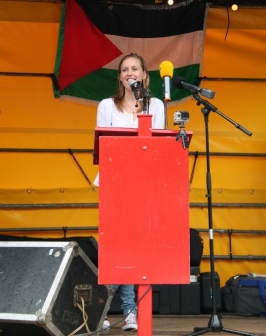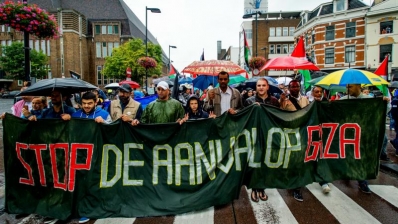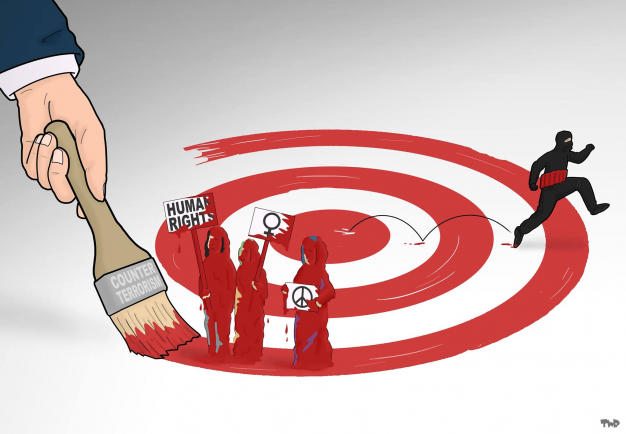On August 10th, Lisanne Boersma, intern at WPP, was among the initiators of a peace demonstration for Gaza in Utrecht, a student city in the Netherlands. The peace demonstration brought together over 1500 people, calling for an immediate end of violence in Gaza and taking steps for a sustainable peace. In this blog, she elaborates on her motivation to take action for peace: that despite the general emphasis on war and violence, she beliefs that peace is possible. Taking her example of standing for justice for the Palestinian people, she encourages others to stand up and belief in the power of peace and justice as well.
Believing in peace is like believing in princesses and enchanted frogs. Believing in peace is not understanding the world we are living in. But who does? Who understands the current mass killings in several places around the world? Who understands the people who are suppressing others for a piece of land? Who understands racism? Who understands whether we have to bomb Iraq or not? But more importantly, who wants to make us believe that peace is nothing more than a dream?
The world we are living in teaches us about war, fighting, honor and revenge. In history class I was taught about world wars, their causes, the way they developed and the (political) actors involved. I was taught about the collapse of world powers, rebels, cruel tsars and so on, but when did I learn something about how people made peace? How many people actually know what Ghandi did, exactly? Who knows more about Nelson Mandela than only his face and a quote on a picture on Facebook? What do we know about nonviolent possibilities to change the world?
 After World War II in Europe they said: ‘Never again’. But in the meantime we are still investing in weapons, supporting repressive regimes, and often see military interference as the only option to resolve international conflicts. This, and the current austerity in international development cooperation, leads to only more troubles and wars around the world. Instead of investing in peace, we merely appear as firefighters whenever there is a crisis.
After World War II in Europe they said: ‘Never again’. But in the meantime we are still investing in weapons, supporting repressive regimes, and often see military interference as the only option to resolve international conflicts. This, and the current austerity in international development cooperation, leads to only more troubles and wars around the world. Instead of investing in peace, we merely appear as firefighters whenever there is a crisis.
I’m 26 years old and I do not understand much of this world, but what I do understand is that many of the current (world) leaders have an interest in dividing people, are benefited by groups fighting each other, thereby maintaining the existent power systems. In short: making us believe that peace isn’t possible.
Peace is not only something that brings relief to the people in unstable countries; it benefits us all. Peace has a positive effect on combating poverty, reduces the amount of refugees, and leads to less people being traumatized by bloody conflicts, currently happening in the Middle East -Syria, Iraq, Gaza - but also in other parts of the world.
I believe we can help people, including ourselves, more effectively by investing in peace, peace education, dialogue and mutual understanding. Our governments and investment banks should support peace programs instead of investing in weapons. It also includes Parents teaching their children about solidarity, teachers incorporating nonviolent actions in their curriculum, and religious leaders emphasizing on the peaceful message within religion.
In the last few weeks there were many mass demonstrations around the world, people standing up for the oppressed people of Palestine. People around the world spoke out for peace and justice. This reinforced my belief that peace is possible. This was my motivation to organize a pro-peace demonstration myself in Utrecht, a student city in the Netherlands. In only slightly more than a week me and six other active citizens transformed my idea of a pro-peace demonstration into a manifestation of about 1500 demonstrators. We also generated much media attention, giving many interviews and issuing reports in local and national newspapers and television. I was both overwhelmed and surprised by the influence I had on spreading a plea for peace.
 At this demonstration, I stood up for human rights and the lives of the Palestinians, but I also wanted to show that I do not want to live in a world where people are leading our world with dollar signs in their eyes. I wanted to show that I and all the other protestors believe in peace, and that we want peace. ‘Never again’ means peace for everyone, everywhere.
At this demonstration, I stood up for human rights and the lives of the Palestinians, but I also wanted to show that I do not want to live in a world where people are leading our world with dollar signs in their eyes. I wanted to show that I and all the other protestors believe in peace, and that we want peace. ‘Never again’ means peace for everyone, everywhere.
Link to local newspaper (in Dutch)
Link to national newspaper NOS (in Dutch)
Pictures by NOS and Vincent Wijlhuizen.
Lisanne Boersma is an intern at the Women Peacemakers Program (WPP). Last year she graduated from the MA Religion in Modern Societies with a major in Islamic studies at Utrecht University. During her studies and her internship at Movies that Matter she got more and more interested in human rights. For her master thesis she did research on the role of religion in peace processes. Because of her activities in an orphanage in India, at Amnesty International, VluchtelingenWerk and Mensen met een Missie she discovered that she wants to focus on the intersection of these three subjects: religion, human rights and peace. With her internship at WPP she hopes to add gender to this list. She writes about these subjects on her blog www.lisanneb.nl
11 Dec '17 This month WPP staff interviewed Arbia Jebali and Sarah Chamekh from Free Sight Association in Tunisia about the work their organization does, how civil society space has changed over the years, which challenges they are facing now, and how civil society in Tunisia is organizing itself to overcome those challenges.
7 Nov '17 In this article, WPP staff interviewed Doron Joles of XminY Fund, an activist organization that supports social movements, action groups and changemakers fighting for a fair, democratic, sustainable and accepting world. He discusses the unique way they have chosen to hand out funds, and the challenges that go along with funding small activist organizations in the current global climate.

25 Oct '17 This Friday, the UNSCR 1325 Open Debate will take place once again, seventeen years since the adoption of landmark UN Security Council Resolution 1325 on Women, Peace and Security. In this article WPP staff reflects on the progress made for a truly transformative feminist peace agenda until now.
